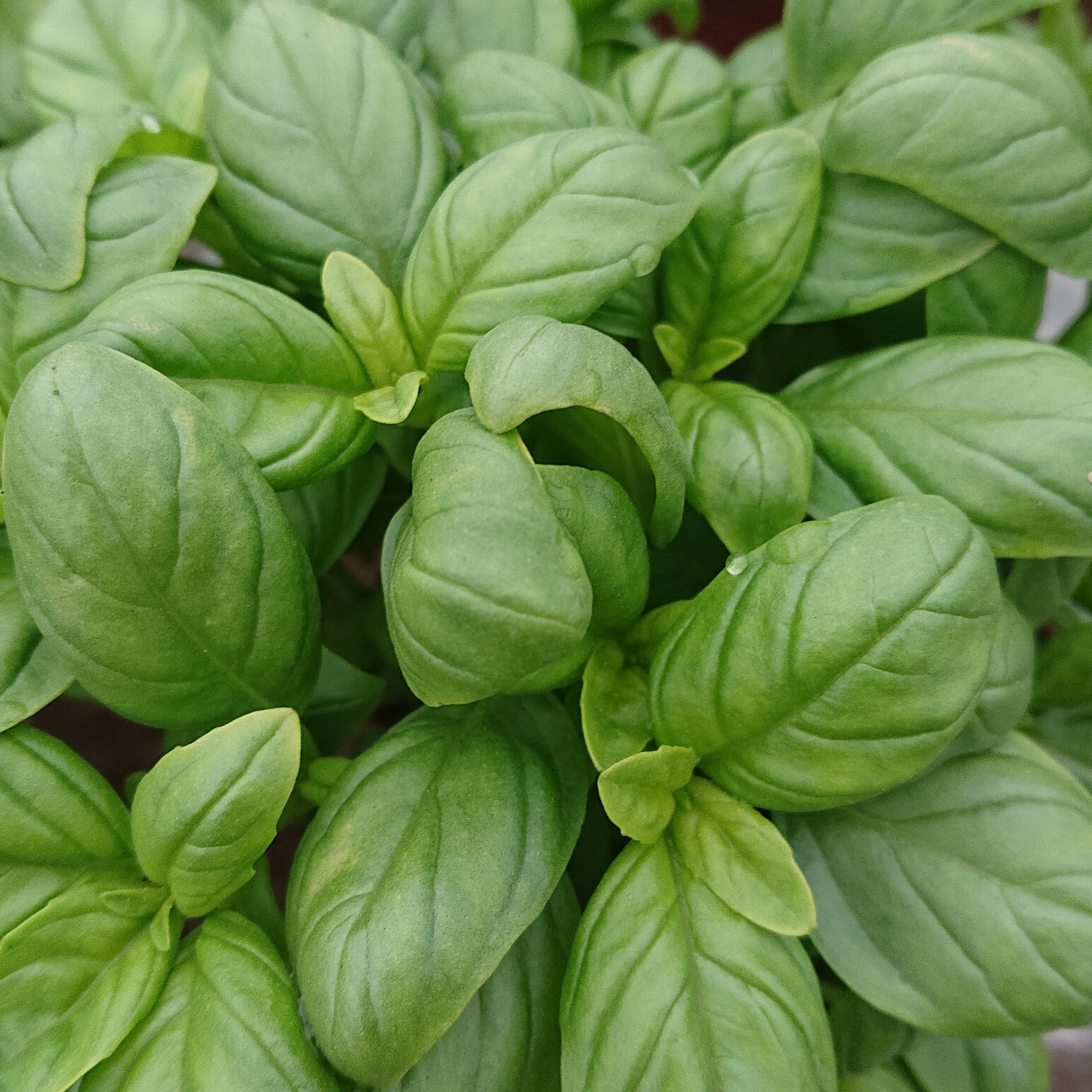Ocimum basilicum
Basilikum
Englische Bezeichnung: Basil
Spanische Bezeichnung: Albahaca
Familie
Lippenblütler (Lamiaceae)
Hauptbestandteile:
Flavonoide, Triterpene, Ursolsäure, ätherische Öle
Verwendung:
Blatt
Wirkungsweisen:
-
lterativ
-
antiemetisch (gegen Brechreiz wirksam)
-
antimikrobiell
-
antioxidativ
-
krampflösend
-
karminativ (beruhigend für den Verdauungstrakt)
-
schmerzlindernd
-
schweißtreibend
-
milchflussfördernd
-
nervenstärkend
Geschmack:
Scharf
Energie:
Wärmend, trocken
Ernte-Hinweise:
-
Mit einer scharfen Schere oder Messer die Blätter abschneiden, anstatt sie mit den Fingern zu pflücken
-
bestenfalls ganze Triebspitzen auf eine Länge von fünf bis sieben Zentimeter abschneiden
Basilikum ist am bekanntesten für sein starkes Aroma und seinen ausgeprägten Geschmack. In der kulinarischen Welt wird es häufig frisch mit Tomaten gepaart oder in getrockneter Form in einer Vielzahl von Gerichten verwendet.
In der Kräuterkunde wird Basilikum als aufmunterndes Nervengift bei Stress, Angstzuständen, schlechter Stimmung, Gedächtnis- und Konzentrationsschwäche eingesetzt.
Wie viele Nervengifte wirkt Basilikum positiv auf das Verdauungssystem, wo es hilft, die Verdauung und die Aufnahme von Nährstoffen zu verbessern (kein Wunder, dass es ein so großartiges Küchenkraut ist!), sowie Verdauungsstörungen, Übelkeit und Darmkrämpfe zu lindern.
Basilikum wird auch bei Erkrankungen der Atemwege eingesetzt und ist speziell bei überschüssigem Schleim in Kopf und Brust angezeigt. Es kann eine ausgezeichnete Ergänzung zu einer Teemischung für Erkältungen, die Grippe und andere Infektionen der Atemwege sein.
Resources:
Tierra, M. (1998). Planetary herbology. Santa Fe, NM: Lotus Press.
McIntyre, A., & Boudin, M. (2012). Dispensing with tradition: A practitioner’s guide to using Indian and Western herbs the Ayurvedic way. Great Rissington, UK: Artemis House.
Vlase, L., Benedec, D., Hanganu, D., Damian, G., Csillag, I., Sevastre, B., … Tilea, I. (2014). Evaluation of antioxidant and antimicrobial activities and phenolic profile for Hyssopus officinalis, Ocimum basilicum and Teucrium chamaedrys. Molecules, 19( 5), 5490-5507. https://doi.org/10.3390/molecules19055490
Family
Lamiaceae
Parts Used:
Leaves
Key Constituents:
flavonoids, triterpenes, ursolic acid, essential oils
Harvesting Guidelines:
-
Use sharp scissors or a knife to cut off the leaves instead of picking them with your fingers
-
At best, cut off whole shoot tips to a length of five to seven centimeters
Properties:
-
alterative
-
analgesic
-
anticatarrhal
-
antiemetic
-
antimicrobial
-
antioxidant
-
antispasmodic
-
carminative
-
diaphoretic
-
galactagogue
-
nervine
Taste:
Pungent
Energy:
Warming, Drying
Basil is most well known for its strong aroma and distinct flavor. It is commonly paired fresh with tomatoes in the culinary world, or used in its dried form in a variety of dishes.
In herbalism, basil is used as an uplifting nervine for stress, anxiety, low mood, and poor memory and concentration. As do many nervines, basil positively impacts the digestive system, where it helps to improve digestion and the absorption of nutrients (no wonder it makes such a great culinary herb!), as well as ease indigestion, nausea, and intestinal spasm.
Basil is also used for respiratory conditions and is specifically indicated for excess mucus in the head and chest. It can be an excellent addition to a tea blend for colds, the flu, and other respiratory infections.
Familia
Lamiaceae
Partes aprovechables:
Hojas
Principales Constituyentes:
flavonoides, triterpenos, ácido ursólico, aceites esenciales
Indicaciones de Cosecha:
-
Utiliza unas tijeras afiladas o un cuchillo para cortar las hojas en lugar de cogerlas con los dedos
-
En el mejor de los casos, corte las puntas enteras de los brotes a una longitud de cinco a siete centímetros
Propiedades:
-
alterador
-
analgésico
-
anticatarral
-
antiemético
-
antimicrobiano
-
antioxidante
-
antiespasmódico
-
carminativo
-
diaforético
-
galactógeno
-
nervioso
Sabor:
Fuerte & Unico
Energía:
Calentador, Secante
La albahaca es muy conocida por su fuerte aroma y su sabor característico. En el mundo culinario se suele combinar fresca con los tomates, o se utiliza en su forma seca en una gran variedad de platos.
En la herboristería, la albahaca se utiliza como nervio estimulante para el estrés, la ansiedad, el mal humor y la falta de memoria y concentración. Al igual que muchas sustancias nerviosas, la albahaca tiene un impacto positivo en el sistema digestivo, donde ayuda a mejorar la digestión y la absorción de nutrientes (¡no es de extrañar que sea una hierba culinaria tan buena!), así como a aliviar la indigestión, las náuseas y los espasmos intestinales.
La albahaca también se utiliza para las afecciones respiratorias y está indicada específicamente para el exceso de mucosidad en la cabeza y el pecho. Puede ser una excelente adición a una mezcla de té para los resfriados, la gripe y otras infecciones respiratorias.







































